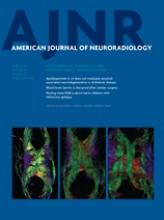We thank Drs Wang and Yuan for their detailed mathematic analysis of our Technical Note entitled “A Flow-Diverting Stent Is Not a Pressure-Diverting Stent.” The authors indeed made a good observation that the SILK stent (Balt Extrusion, Montmorency, France) was not optimally deployed at the initial stage of the procedure. The cause of the suboptimal initial deployment was either due to the mass effect by the aneurysm or to focal vasospasm. The latter is less likely because treatment had already been performed at day 3 after presentation, but more important, the patient did not show signs of a subarachnoid hemorrhage.
The illustration (Fig 1 in the original article) indeed shows that the struts of the Silk stent are arranged at an angle indicating deployment below its nominal diameter. In such circumstances, the flow-diversion effect was probably less than at optimal (nominal) deployment. This difference might have impacted the flow-dynamic effect in that measurements with the ComboWire (Volcano Corporation, Rancho Cordova, California) were affected, and the pressure and flow reduction might have been better when optimal deployment was achieved. However, despite the drawback, we did see changes in the pressure inside the aneurysm with time (Fig 2 in the original article), with a temporary reduction in pressure inside the aneurysm but a subsequent return to baseline values 5 minutes after deployment (from t = 5 minutes to t = 10 minutes). The deployment of the stent remained stable during this interval; therefore, the alteration in the pressure curve occurred when the stent was suboptimally deployed. One might question whether intra-aneurysmal pressure would have dropped more in a situation of optimal deployment. However, this change could only have occurred if substantial leakage had existed through the aneurysm wall or via other exit pathways. In this case, simple physics dictates intra-aneurysmal pressure to be Pintra = Part·Rleak/(Raccess + Rleak), with Part, the local arterial pressure; Raccess, the access resistance through the stent; and Rleak, the resistance of the leakage pathways. A better deployment raises Raccess, but there seems very little reason to assume that it would approach the high resistance of any tiny leakage pathways, if these exist at all. Hence, we expect intra-aneurysmal pressure to be nearly equal to intra-arterial pressure, even when stent deployment is more optimal. Of relevance, on the basis of similar physics, pressure pulsations in the aneurysm are expected to be damped better if access resistance is higher or if aneurysmal compliance is higher. Alas, we did not perform any repeat measurements in other patients to confirm such physical analysis.
In addition to our own response, we also asked for the manufacturer of the Silk stent, Mr N. Plowiecki, to respond. He agreed with the analysis of the stent struts and deployment by Drs Wang and Yuan and supports their statements that the analysis of the flow-dynamic effect should be seen in relation to and as a function of the angle of the struts of the stent.
At present, we have a 3-year follow-up on the occlusion rate of the aneurysm. On a recent contrast-enhanced MR angiography study, complete occlusion of the aneurysm is seen. Moreover, the mass effect of the aneurysm has diminished. The suboptimal deployment of the Silk stent has at least not hindered the progressive occlusion of the aneurysm. The patient is in stable neurologic condition, and no hemorrhage has occurred since treatment.
- © 2013 by American Journal of Neuroradiology












